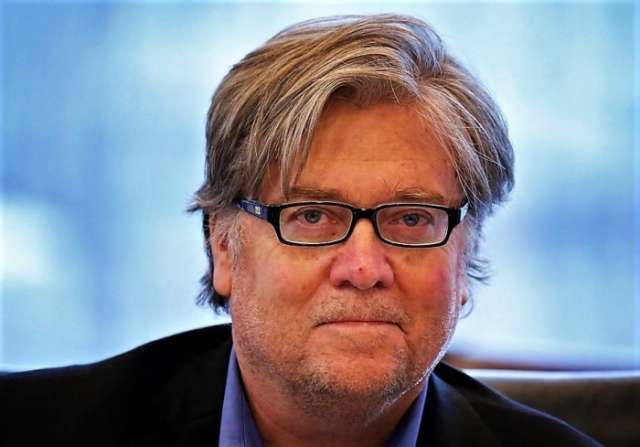But the book mostly tells us what most of political-journalistic Washington already knew: that Trump is unqualified to be president and that his White House is a high-risk area of inexperienced aides. The only surprise is that more calamities haven’t occurred – at least not yet.
A good portion of what was released before the book’s publication concerns a battle between two of the most talkative, argumentative, self-regarding braggarts US politics has ever seen: Trump and his one-time chief strategist, Stephen Bannon. In the summer of 2016, with his campaign lacking a leader, Trump made Bannon – a scruffy, scrappy former businessman who was then the executive chair of Breitbart News, a website preaching white nationalism – the campaign’s chief executive. Bannon was full of big ideas about what a right-wing “populist” campaign would look like.
In many ways, however, Bannon’s ideal campaign closely resembled what Trump was already saying and doing: appealing to blue-collar workers by attacking immigration – for example, saying that he’d build “a big, beautiful wall” along the border with Mexico, for which the Mexicans would pay – and trade agreements that Trump alleged were unfair to the US. These voters came to form the core of Trump’s base, and his success in wooing them, combined with Hillary Clinton’s stunning failure to do so, goes a long way toward explaining why he is president and she is not.
The problem for Trump is that the citizens he was wooing have never added up to a near-majority of voters. His famous “base” is well under 40% of the public. But Trump and Bannon apparently preferred not to think about that.
Trump is prone to taking out his frustrations on others – he is never to blame for his failures – and inevitably these landed on Bannon, who bragged more than was good for him about his power in the White House and asserted more than he should have. Bannon was ousted from the administration and left in August. Though he and Trump stayed in touch, in retrospect, an eventual falling out seems to have been inevitable.
Trump and Bannon were like two overweight men trying to share a single sleeping bag. Their political world wasn’t big enough for both. They disagreed bitterly over whom to back in the race to fill a Senate seat from Alabama; but, at Bannon’s urging, Trump ultimately backed the erratic former state Supreme Court judge Roy Moore, who’d been removed from the bench twice, and who lost the race. Bannon was seeking to shake up the Republican “establishment” by backing similar “outsider” candidates in this year’s midterm elections, which, if successful, could make it all the harder for Trump to obtain victories in Congress.
Despite his denials, it was Trump who more or less agreed to allow Wolff, whose reputation for slashing his subjects Trump presumably would have known from his years in New York City, to interview the White House staff for a book. Some aides say they believed they were talking to Wolff “off the record,” meaning that they wouldn’t be publicly associated with their remarks. But, even if that were true, it was hardly soothing to a furious president: they had said these things.
In Trump’s view, Bannon’s great sin with regard to Wolff’s book was to say highly negative things about the president’s family. Trump was particularly infuriated by Bannon’s description of a now-famous meeting that his son, Donald Jr., and other senior campaign staff held in Trump Tower in June 2016 with some Russians who said that they had “dirt” on Hillary Clinton. Bannon told Wolff that the meeting was “treasonous.” But, depending on what actually transpired in that meeting, Bannon might not have been so far off. (Trump himself participated in a meeting aboard Air Force One, as he returned from his second presidential trip abroad, to draft a statement to cover up what happened in that Trump Tower meeting.)
Trump was also reportedly furious that Bannon had described the president’s favorite child, Ivanka, as “dumb as a brick.” Wolff also reports that Ivanka and her husband, White House senior adviser Jared Kushner, had agreed that after their expected smashing success at the White House, it would be Ivanka who would run for president.
Overstating matters, as is his wont, Trump claimed, in effect, that Bannon had had nothing to do with his election victory, and that the two had almost never talked one on one. And, as is his wont, Trump threatened to sue Bannon. Trump has a long track record of threatening lawsuits without ever filing them, but even the threat can be costly to the putative target.
Yet the momentary obsession with the feuding within the Trump camp shouldn’t obscure other realities. Behind the drama, Trump has certain clear goals, and cabinet and agency heads who share them – and who don’t get distracted by the publication of a juicy account of the president’s behavior.
While much of Washington and its press corps were discussing the latest revelations, the Department of Justice, which is supposed to be somewhat independent of the White House, was being turned into a partisan instrument for pursuing the president’s grudges. Indeed, last week, it was disclosed that the DoJ was reopening an investigation into the already thoroughly investigated matter of Hillary Clinton’s emails. The FBI, it was also disclosed, would be looking into the Clinton Foundation.
The use of a government agency to punish a president’s previous opponent recalls the behavior for which Richard Nixon was impeached, and suggests a very different form of government than a democratic one.
Elizabeth Drew is a contributing editor to The New Republic and the author, most recently, of Washington Journal: Reporting Watergate and Richard Nixon's Downfall.
The original article was published in project-syndicate.org.
More about: #Trump
















































